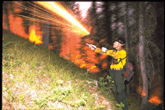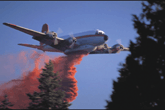The National Interagency Fire Center in Boise, Idaho, has 'the world's largest cache of portable communications equipment,' said Stephen Jenkins, director of the center's Communications Division.He manages a collection of 8,000 handheld radios in a variety of bands plus portable satellite and microwave communications systems, public address systems, assorted cell and satellite phones, and fax machines.They're all used by firefighters battling wildfires, and that's a big job. Through August, more than 61,000 fires burned this year on 6.3 million acres in the 50 states and Puerto Rico.'There have been times when we had nothing in the shop,' Jenkins said. At one point in August, 40 crews were brought in from Canada. 'We asked them to bring their own radios, because all of ours were out,' he said.In addition to comm equipment, the division also manages the radio frequencies, trying to find enough bandwidth for thousands of firefighters at dozens of fires.Jenkins, who works for the Forest Service, said he hopes a new generation of equipment will simplify the job.'We are starting to move to digital,' he said. It will take three to five years to get there, but 'digital is a whole new ball game that will give us the ability to do things we couldn't do before.'Those things include using the Global Positioning System and radio over IP wireless networks, and having the flexibility to mix and match equipment to operate on varying frequencies.The move is possible because of Project 25, a standard for interoperable digital radio being developed by the Association of Public Safety Communications Officials. The APCO standard lets users with different vendors' equipment talk.'This is the first time this has happened,' said Jim Ridgell, vice president of federal business for E.F. Johnson Co. of Lincoln, Neb. 'The technology is up and running,' and demand is high because of the push after Sept. 11 for secure, interoperable communications.The proposed fiscal 2003 budget earmarks $1.3 billion to improve communications among federal, state and local agencies. Much of that money will go for the purchase of digital equipment.E.F. Johnson and Motorola Inc. are two of the first companies to manufacture APCO 25-compliant equipment. Others are Kenwood USA Corp. of Long Beach, Calif., and Maycom Audio Systems of the Netherlands.'There are maybe five or six manufacturers now,' Ridgell said. 'A year from now there might be 20.'Although the center's focus is fighting fires, it also provides communications support for Christmas tree lighting ceremonies in Washington, papal visits, protection of nuclear power plants during hurricanes, and various emergencies as far afield as Africa and Russia.Sometimes communications frequencies have to be borrowed from other agencies, and the problem is worse in the eastern United States.'My frequencies are clear as a bell west of the Mississippi,' Jenkins said. 'When we get into New York and Washington, we have to have extra frequencies. This year we probably tapped 200 extra frequencies from other agencies.'He has borrowed dedicated frequencies from the Navy, for example, to fight fires in inland states such as Colorado.The division generally uses VHF bands between 162 MHz and 174 MHz for tactical communications. Federal workers in the field often communicate with state workers in the 150-MHz band.'In the last 15 years we've gotten radios that span those frequencies,' Jenkins said.UHF is used for backbones, and cell phones and satellite phones for logistics. With such a variety of radio equipment, the division has struggled for years to resolve multiband and interoperability problems, sometimes with homegrown solutions.'We built cross-link boxes ourselves' to tie together different bands, Jenkins said. 'We also built a box that would go from AM to FM.'Airplanes have AM radios, but firefighters on the ground use FM. Most planes that routinely work fires also have FM. But if extra aircraft are needed quickly, a link is needed for the two groups to communicate.'We put the box on a hill,' Jenkins said. 'It goes in AM and comes out FM to the guys on the ground.'Several years ago NIICD ran into a nightmare coordinating work at multiple fires in Florida, where many local agencies had 800-MHz trunking systems of their own.'We had a horrible time connecting in Florida,' Jenkins said. 'We could not interface with that trunking system.'Today, crossover boxes are commercially available, but 'three or four years ago we didn't have that,' he said.A wholesale switch to digital technology would ease the interface problems, although Jenkins is under no illusions about how easy it will be.'They're very expensive radios,' he said. 'They're three times what I pay for a radio today.'The new federal money and increased competition should make digital radios more affordable, although it will take years for the equipment to be widespread at state, local and federal agencies.During the transition, digital will become just one more in the mix of technologies that Jenkins' cache must accommodate.'It's going to cause us a lot of problems' before it becomes a panacea, he said.
Each fire season, the National Interagency Fire Center patches together communications links between firefighters on the ground and in the air, using limited bandwidth and incompatible analog radio equipment.
National Interagency Fire Center








